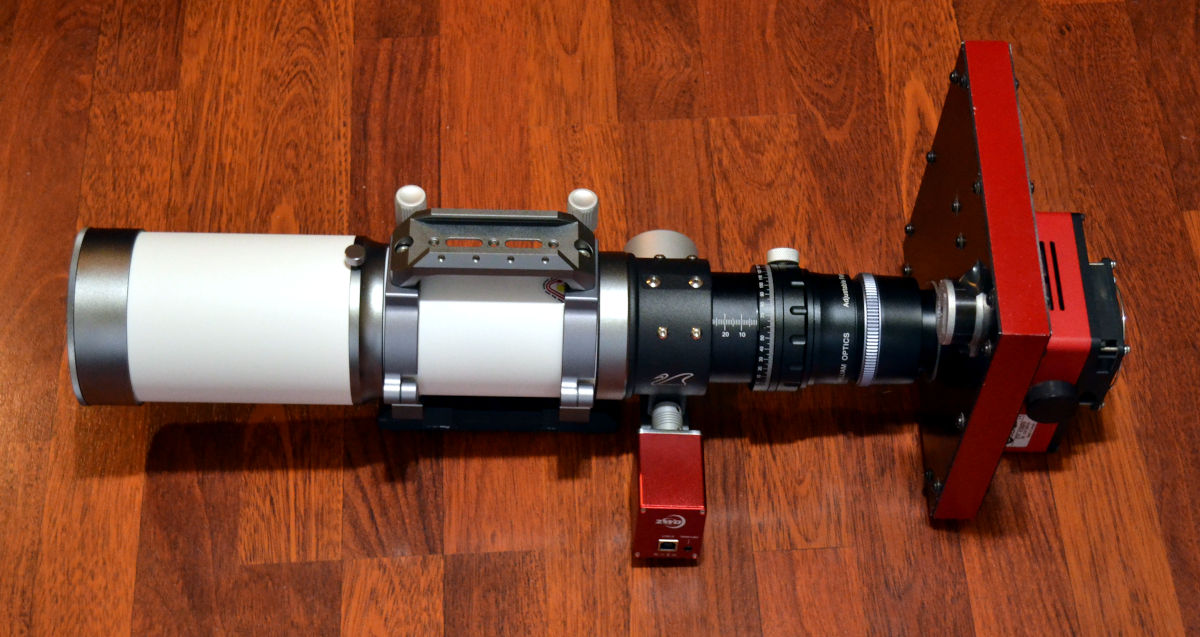William Optics GT81
I just bought a William Optics GT81 telescope from Agena Astro. I figured I could use it for those pesky galaxy clusters and large nebulae that just don't fit in the frame on the big scope. When it's not driving the imaging camera it can drive the guiding camera for the LX600. After using it for a while, I think it will mostly be used for imaging.
I'm impressed by the obvious build quality. Before converting to auto-focus I tried the 2-speed focuser out. Smooth as silk. The dew shield slides smoothly, and the lens cap is substantial and also contains a clear Bahtinov mask. Everything about the scope feels quality.
The first task in preparing it for use was to install an EAF auto focuser. I removed the single knob on the left, the draw tube locking screw and the two set screws from the unused holes at either end of the focuser pinion shaft, next to the knobs. Two screws in the set screw holes hold the bracket on the pinion body and two hold the EAF to the bracket. The GT81 comes with a cover for the 2-speed focuser knobs, and I left it on to reduce the temptation to turn them. The EAF doesn't allow for manual focusing.
Then I installed the Flat6AIII field flattener/focal reducer. It involves loosening three tiny set screws which are used to clamp the 2" eyepiece adapter in place. That takes a 1.5mm allen wrench. The adapter unscrews and the Flat6AIII screws on in its place. The flattener/reducer has a 48mm x 0.75 male, "wide-T", at the camera end. I couldn't be happier. My filter wheel has a 48mm x 0.75 female. The flattener had no useful instructions, but you can find an infographic on the William Optics web site. It is as simple as they show. I had to add 1mm to the already 62.1mm back focus required for the GT81 to account for my 3mm filter thickness. My imaging train with filterwheel and camera takes up 47.5mm leaving 15.6mm to pad. I added a 10mm wide-T spacer to the camera and set the flattener to 5.6mm. Either I calculated right or the back focus is really forgiving, because the first image frame I took was perfect. I suspect I calculated right - experience tells me reducers are not forgiving of back focus errors.
The rear of the flattener unscrews, eventually (it has long threads), and inside the part that comes off is a place to install a 2" mounted filter. That works out great for my Baader Neodymium Moon and Skyglow filter, without which I could not operate at all. I have bortle 7-8 normally, and then the high school field across the street turns on 72 (36 of them pointing at my backyard) huge lamps for the football game every Friday night.
The camera and filter wheel weigh right at 3.5lbs and don't appear to tax the focuser at all. With the scope, field flattener and filterwheel/camera it weighs in at just over 13lbs. A lot to be mounting on top of the LX600. I had to reuse the Starlock shoe, which looks a lot like a vixen. I made the mistake of only measuring the width at the bottom of the shoe. The width is the same, but the angle more shallow, making it about 2mm narrower at the top than the Vixen. I was about to get really disappointed when in desperation I pulled the dovetail off of the Starlock guide scope and tried it on the GT81. It fit perfectly. Crisis averted.

Attached to the LX600 solidly, big end up, the scope was ready to go. All I had to do was focus it so I could solve an image to sync the mount with the heavens above. The EAF auto focuser has 100000 steps maximum in firmware. 8360 steps later and I had focus. 8360 steps equates to about 27.5 mm of draw tube travel.
This is my first experience with a real refractor. The stars are round at any state of focus. I zoomed all of the way in the application and focused on the dimmest stars to make sure I had it. The dimmer stars were pinpoints and the brighter ones were just slightly larger points of light. Amazing. It is much easier than focusing a 12" LX600. With the little scope I get 2.92 arcseconds per pixel, whereas with the big scope I get 0.46 arcseconds per pixel.

This is the Iris nebula, taken the night after the full moon. 120 x 60 second exposures with a Baader Moon and Skyglow filter. I used Siril to eliminate the gradient from the Moon.